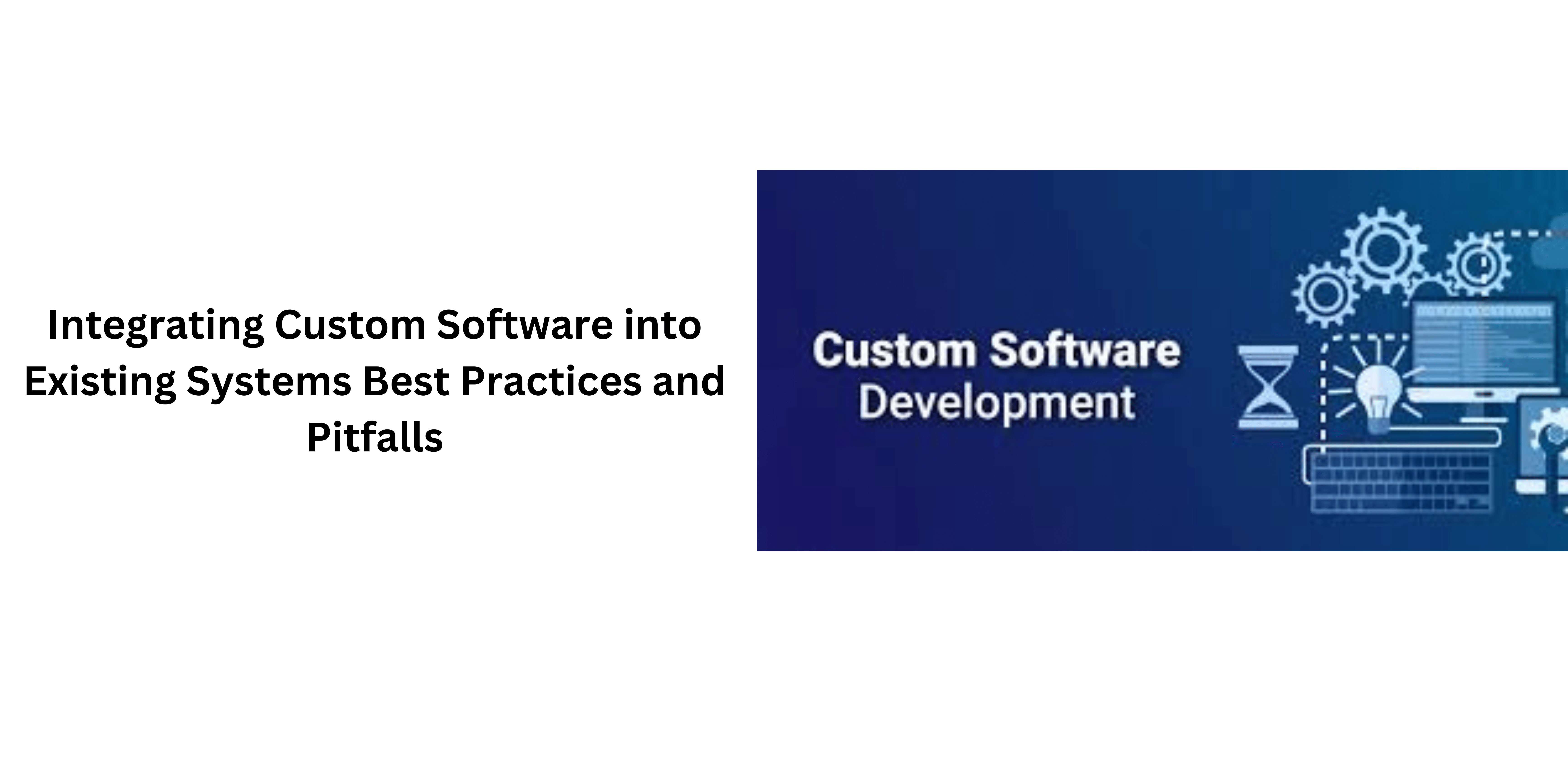In the ever-evolving landscape of technology, the seamless integration of custom software into existing systems has become a critical facet of organizational growth and efficiency. This process demands a nuanced understanding of system architectures, a meticulous evaluation of the current software infrastructure, and a strategic alignment of integration goals with broader business objectives.
As businesses strive to enhance their operations, pitfalls and challenges abound, necessitating a comprehensive approach to navigate through the complexities. This introduction serves as a gateway to exploring the best practices and potential pitfalls associated with integrating custom software development. From addressing compatibility issues and data migration strategies to navigating security concerns and striking a balance between customization and standardization, organizations embark on a journey fraught with considerations.
This discourse aims to shed light on key facets of successful integration, guiding enterprises towards informed decision-making and ensuring a harmonious fusion of custom solutions into the fabric of existing systems.
Assessment of Existing Software Infrastructure
The assessment of existing software infrastructure is a crucial first step in the process of integrating custom software into established systems. This comprehensive evaluation involves a thorough examination of the current software landscape, analyzing both the strengths and weaknesses of the existing architecture. The primary objective is to gain a deep understanding of the various components, modules, and dependencies within the system.
During this assessment, it is imperative to identify legacy systems, obsolete technologies, and potential bottlenecks that might impede the integration process. Compatibility issues between the new custom software and the existing infrastructure are often unearthed at this stage, necessitating strategic planning to address such disparities. Moreover, evaluating the scalability of the current system is paramount to ensure that it can accommodate the anticipated growth and increased workload associated with the integration.
A comprehensive assessment also delves into the performance metrics of the existing infrastructure, examining factors such as response times, data throughput, and system reliability. This data-driven approach provides a baseline for comparison post-integration, aiding in the measurement of the success of the integration process.
Furthermore, the assessment should consider the human element, considering the proficiency of the current workforce in utilizing the existing systems. Identifying potential skill gaps and training needs is essential to prepare the workforce for the impending changes, ensuring a smooth transition and minimizing disruptions during the integration process.
In essence, the assessment of existing custom software infrastructure serves as the cornerstone for developing a well-informed integration strategy. It enables organizations to proactively address challenges, optimize performance, and lay the groundwork for a successful assimilation of custom software into the pre-existing technological ecosystem.
Defining Integration Objectives and Requirements
Defining integration objectives and requirements is a pivotal phase in the process of incorporating custom software into existing systems. This step involves clearly articulating the goals that the integration seeks to achieve and outlining the specific criteria and functionalities required for success.
The first aspect of this process is establishing strategic integration objectives aligned with the overall business objectives. These objectives might include improving operational efficiency, enhancing data accessibility, fostering real-time collaboration, or ensuring seamless communication between disparate systems. A well-defined set of integration goals provides a roadmap for the entire process, guiding decision-making and resource allocation.
Simultaneously, detailing the technical requirements is essential. This involves specifying the necessary features, functionalities, and performance benchmarks expected from the custom software solutions. Compatibility with existing technologies, data formats, and communication protocols must be clearly outlined to ensure a cohesive integration process.
Moreover, identifying key performance indicators (KPIs) is integral to measuring the success of the integration. Whether it’s reducing processing times, minimizing errors, or increasing system scalability, quantifiable metrics enable organizations to assess the impact of the integration on their operations.
Collaboration with stakeholders from different departments is crucial during this phase to gather diverse perspectives and requirements. Understanding the needs of end-users, IT teams, and management ensures that the integration aligns with the broader organizational context.
In summary, defining integration objectives and requirements sets the stage for a purposeful and targeted assimilation of custom software. By establishing clear goals and technical specifications, organizations can streamline decision-making, mitigate potential challenges, and ultimately realize the intended benefits of integrating new software into their existing systems.
Compatibility and Interoperability Considerations
Compatibility and interoperability considerations play a pivotal role in the successful integration of custom software into existing systems. This critical phase involves a comprehensive analysis of how well the new software aligns with and operates alongside the current technological environment.
Firstly, assessing compatibility involves evaluating whether the custom software can seamlessly interact with the existing hardware, operating systems, and databases. Potential challenges such as version disparities, data format inconsistencies, or conflicting dependencies need to be identified and addressed proactively. This ensures a smooth integration process, minimizing disruptions to ongoing operations.
Interoperability, on the other hand, focuses on the software’s ability to communicate and exchange data with other systems within the organization. This includes understanding the existing application programming interfaces (APIs), middleware, and communication protocols. Implementing standardized interfaces and adhering to industry-wide protocols enhances interoperability, facilitating data flow between different components of the IT infrastructure.
Moreover, organizations must consider scalability when evaluating compatibility and interoperability. As business needs evolve, the integrated solution should have the flexibility to accommodate growth without compromising performance. This forward-looking approach prevents the need for frequent system overhauls and adaptations.
Regular testing, simulation of real-world scenarios, and pilot implementations are essential in validating compatibility and interoperability. These practices help identify and rectify potential issues before full-scale integration, reducing the risk of system downtime and data inconsistencies.
In essence, a meticulous focus on compatibility and interoperability ensures that the integration of custom software harmonizes with the existing technological ecosystem. By addressing these considerations, organizations pave the way for a cohesive, efficient, and future-ready IT infrastructure that can readily adapt to changing business requirements.
Data Migration Strategies
Data migration strategies form a critical component of the integration process when incorporating custom software into existing systems. This intricate process involves the seamless transfer of data from legacy systems to the new infrastructure, ensuring continuity, accuracy, and accessibility.
Firstly, a comprehensive data assessment is essential. This involves identifying the types of data, their formats, and the relationships between different datasets. Understanding the data landscape helps in formulating a targeted migration strategy tailored to the specific needs of the organization.
Data cleansing and transformation are crucial steps in preparing the existing data for migration. This includes resolving inconsistencies, standardizing formats, and ensuring data quality to prevent issues such as duplication or inaccuracies from permeating into the new system.
Choosing the appropriate migration method is another pivotal decision. Strategies may involve a one-time bulk transfer, incremental updates, or a phased approach, depending on the scale and complexity of the data. Each method comes with its own set of considerations, such as downtime tolerance, resource utilization, and data synchronization requirements.
Ensuring data security and compliance throughout the migration process is paramount. Encryption, access controls, and auditing mechanisms must be in place to safeguard sensitive information and adhere to regulatory standards. Additionally, contingency plans for data rollback in the event of unforeseen issues are crucial to mitigate risks.
Testing is a continuous aspect of data migration, involving both functional and performance testing. Simulating real-world scenarios helps identify and rectify potential issues before the new software goes live, minimizing the impact on daily operations.
In essence, a well-executed data migration strategy is fundamental to the success of integrating custom software. It safeguards data integrity, ensures a smooth transition, and lays the foundation for leveraging the full potential of the new system within the existing infrastructure.
Security Measures for Seamless Integration
Implementing robust security measures is imperative for ensuring the seamless integration of custom software into existing systems. As organizations embrace technological advancements, they concurrently expose themselves to potential security threats and vulnerabilities. A strategic approach to security is vital to safeguard sensitive data, maintain system integrity, and protect against unauthorized access.
Authentication and access controls are foundational security measures. Utilizing strong authentication methods, such as multi-factor authentication, helps verify the identity of users, preventing unauthorized access. Access controls ensure that individuals have appropriate permissions based on their roles within the organization, limiting the risk of data breaches.
Encryption plays a pivotal role in securing data during transit and at rest. Implementing strong encryption algorithms helps protect sensitive information from interception or unauthorized access. This is particularly crucial when data is transmitted between different systems during the integration process.
Regular security audits and vulnerability assessments are essential for identifying and addressing potential weaknesses in the system. Continuous monitoring of the integrated environment helps detect anomalies and potential security breaches in real-time, allowing for prompt remediation.
Integrating security into the software development life cycle (SDLC) is a proactive approach to building secure custom software. Conducting security assessments during the development phase helps identify and rectify security issues before the software is deployed.
Employee training and awareness programs contribute significantly to a secure integration process. Educating staff about security best practices, social engineering threats, and the importance of adhering to security policies enhances the overall security posture of the organization.
In summary, incorporating security measures into the integration process is paramount for the successful assimilation of custom software. By focusing on authentication, access controls, encryption, continuous monitoring, and user education, organizations can fortify their systems against potential threats and vulnerabilities, ensuring a seamless and secure integration experience.
Customization vs Standardization Dilemma
The customization vs standardization dilemma represents a pivotal decision point in the integration of custom software into existing systems. Organizations must carefully navigate this balance to meet specific business needs while ensuring efficiency, cost-effectiveness, and long-term sustainability.
Customization allows organizations to tailor software solutions to meet unique requirements and workflows. It addresses specific challenges and aligns closely with the organization’s distinct processes, potentially providing a competitive edge. However, customization comes with drawbacks, including increased development time, higher costs, and potential challenges in maintenance and upgrades. Furthermore, excessive customization can lead to system complexity, making it harder to integrate with other solutions in the future.
On the other hand, standardization involves adopting off-the-shelf solutions or adhering to industry best practices. This approach often offers quicker deployment, cost savings, and easier maintenance and support. Standardized custom software solutions also benefit from regular updates and improvements provided by the software vendors. However, they may not fully address the unique requirements of an organization, potentially resulting in suboptimal efficiency or a lack of competitive differentiation.
The key lies in finding the right balance between customization and standardization based on the organization’s goals, industry, and specific needs. A hybrid approach, where core functionalities are standardized, and unique requirements are addressed through limited and well-managed customization, can provide the best of both worlds. Striking this balance ensures that the integrated system is tailored to meet critical business processes while maintaining the advantages of standardized components in terms of reliability, scalability, and ease of maintenance. Careful consideration of the long-term implications of customization and standardization is essential for organizations aiming to achieve an integration that is both effective and sustainable.
APIs and Middleware Selection
APIs (Application Programming Interfaces) and middleware selection play a crucial role in the integration of custom software into existing systems. These components act as the bridge between different software applications, enabling seamless communication, data exchange, and interoperability.
APIs serve as the connectors that allow different software systems to interact with each other. When selecting APIs for integration, compatibility with existing systems, ease of use, and robustness are paramount. Well-documented APIs with clear endpoints and authentication mechanisms simplify the integration process and contribute to long-term maintainability. Additionally, considering whether the APIs adhere to industry standards promotes interoperability and ensures a smoother integration experience.
Middleware, as an intermediary layer between different software components, facilitates communication and data exchange. When choosing middleware, factors such as scalability, flexibility, and support for different communication protocols should be considered. Middleware solutions that can seamlessly integrate with both custom and existing software contribute to a cohesive and efficient integrated system.
Moreover, security considerations are crucial in API and middleware selection. Ensuring that APIs and middleware components have robust security features, such as encryption and access controls, helps protect sensitive data during the integration process.
The selection process should also consider the long-term viability of APIs and middleware. Choosing solutions with active community support, regular updates, and a roadmap for future development ensures that the integration remains sustainable and adaptable to evolving business needs.
In summary, thoughtful selection of APIs and middleware is instrumental in achieving a successful integration of custom software. Compatibility, documentation, security, and long-term support are key criteria that organizations should consider to build a resilient and interoperable software ecosystem.
Testing and Quality Assurance Protocols
Testing and quality assurance protocols are integral components in the process of integrating custom software into existing systems. These measures are essential to ensure the reliability, functionality, and performance of the integrated solution while minimizing the risk of disruptions to ongoing operations.
Comprehensive testing begins with unit testing, where individual components of the custom software are tested in isolation. This helps identify and rectify any issues at the granular level, ensuring that each module functions as intended. Integration testing follows, focusing on verifying the interactions between different components to ensure seamless communication and data flow.
End-to-end testing is critical to assess the integrated solution as a whole, simulating real-world scenarios to validate its performance under various conditions. This phase also includes stress testing to evaluate the system’s scalability and responsiveness under heavy workloads. Additionally, user acceptance testing (UAT) involves collaboration with end-users to ensure that the integrated solution meets their needs and expectations.
Quality assurance protocols should be embedded throughout the development and integration process. Continuous monitoring, automated testing tools, and regular code reviews contribute to identifying and addressing potential issues proactively. This proactive approach reduces the likelihood of defects or vulnerabilities impacting the integrated system.
Documentation is a vital aspect of quality assurance, providing a reference for system behavior, configuration, and troubleshooting. Well-documented protocols aid in diagnosing issues swiftly and facilitate knowledge transfer, ensuring that the integration remains sustainable in the long run.
In conclusion, testing and quality assurance are indispensable steps in the integration journey, validating the performance, security, and user-friendliness of the custom software within the existing systems. Rigorous testing protocols enhance confidence in the integrated solution, contributing to a smoother and more successful deployment.
User Training and Change Management
User training and change management are pivotal elements in the successful integration of custom software solutions into existing systems. As technological landscapes evolve, organizations must prioritize equipping their workforce with the necessary skills and facilitating a smooth transition to the new software environment.
User training begins with a thorough understanding of the features, functionalities, and workflows associated with the custom software. Tailored training programs, including hands-on sessions and documentation, help users acquire the skills required to operate efficiently within the integrated system. Training should be continuous and adaptive, addressing the diverse needs of different user roles and ensuring that users stay abreast of any updates or enhancements.
Change management is equally crucial, focusing on the human side of integration. It involves communication, collaboration, and creating a positive mindset toward the changes brought about by the new software. Engaging stakeholders, addressing concerns, and highlighting the benefits of the integrated solution fosters a culture of adaptability.
Incorporating feedback loops during the initial phases of integration allows organizations to gather insights from users, identify pain points, and refine training and change management strategies accordingly. This iterative approach contributes to a more user-friendly and widely accepted integrated system.
Recognizing and mitigating resistance to change is an integral part of effective change management. Transparency about the reasons for the integration, addressing concerns, and showcasing the positive impact on productivity and efficiency instills confidence and helps build a supportive environment for the new software.
In summary, user training and change management are inseparable components of a successful integration strategy. By prioritizing user empowerment, fostering a positive attitude towards change, and incorporating feedback mechanisms, organizations pave the way for a seamless and user-friendly transition to the integrated software environment.
Scalability Planning for Future Needs
Scalability planning for future needs is a critical aspect of integrating custom software into existing systems, ensuring that the integrated solution can adapt and grow in tandem with the evolving requirements of the organization. Scalability refers to the system’s ability to handle increased workload, data volumes, and user demands without compromising performance or efficiency.
A comprehensive scalability plan begins with a thorough assessment of the organization’s anticipated growth and changing operational demands. This includes projecting increases in user numbers, data volumes, and transaction frequencies over a defined period. By understanding future needs, organizations can design an integrated solution that accommodates these demands without requiring a significant overhaul of the system.
Architectural considerations play a key role in scalability planning. Adopting modular and flexible architectures allows organizations to add or modify components as needed, facilitating incremental scaling. Cloud-based solutions, with their on-demand resource provisioning, offer a scalable infrastructure that can easily adapt to varying workloads.
Performance testing is an integral part of scalability planning. Simulating scenarios that mimic future usage patterns helps identify potential bottlenecks, assess system response times, and optimize configurations. This iterative testing approach ensures that the integrated solution remains performant and responsive as the organization grows.
Additionally, monitoring tools and analytics should be integrated into the system to provide real-time insights into its performance. This proactive approach enables organizations to detect scalability issues early, allowing for timely adjustments and optimizations.
In essence, scalability planning is an investment in the long-term success of the integrated custom software. By anticipating and preparing for future needs, organizations can build a flexible, resilient, and future-ready system that can seamlessly adapt to the dynamic nature of business requirements and technological advancements.
Documentation and Knowledge Transfer
Documentation and knowledge transfer are foundational elements in the integration of custom software into existing systems, ensuring a smooth transition, fostering collaboration, and enhancing the sustainability of the integrated solution.
Comprehensive documentation is essential to provide a reference for various aspects of the integration, including system architecture, data models, APIs, and configurations. Well-organized and detailed documentation aids in troubleshooting, system maintenance, and onboarding of new team members. It acts as a knowledge repository, capturing the rationale behind design decisions, integration workflows, and any customized components, fostering a shared understanding among team members.
Knowledge transfer involves the dissemination of expertise from those directly involved in the integration process to other stakeholders within the organization. This can be achieved through training sessions, workshops, and mentorship programs. Facilitating a transfer of knowledge ensures that the organization retains institutional understanding, reducing dependencies on specific individuals and creating a more resilient and adaptable workforce.
Documentation and knowledge transfer are interconnected. The documentation serves as a tangible resource that supports effective knowledge transfer, allowing team members to grasp the intricacies of the integrated system more efficiently. Regular updates to documentation, especially during and after integration, ensure that it remains current and relevant.
Moreover, a well-documented system facilitates smoother collaboration between different teams, such as developers, IT support, and end-users. Clear documentation acts as a communication tool, enabling effective collaboration, reducing misunderstandings, and fostering a collaborative environment.
In summary, robust documentation and knowledge transfer are essential components of a successful integration strategy. They empower the organization to maintain, optimize, and troubleshoot the integrated system effectively while cultivating a knowledgeable and collaborative team that can adapt to evolving needs and challenges.
Monitoring and Performance Optimization
Monitoring and performance optimization are indispensable components of the integration process, ensuring the ongoing health, efficiency, and responsiveness of the integrated custom software within existing systems.
Continuous monitoring involves the real-time observation of the integrated system’s key performance indicators (KPIs), such as response times, resource utilization, and error rates. Implementing monitoring tools allows organizations to detect and address issues promptly, preventing potential disruptions and minimizing downtime. Monitoring also provides valuable insights into system behavior under various conditions, aiding in proactive decision-making and optimizations.
Performance optimization is an iterative process focused on enhancing the efficiency and responsiveness of the integrated solution. This involves identifying bottlenecks, optimizing algorithms, and fine-tuning configurations to achieve optimal resource utilization. Regular performance assessments, often through load testing and stress testing, help organizations anticipate scalability challenges and ensure the system can handle increasing workloads.
Scalability considerations are integral to both monitoring and performance optimization. As the organization evolves, the integrated system should be capable of accommodating growth seamlessly. Monitoring tools play a vital role in identifying scalability issues, while performance optimization strategies ensure that the system can scale efficiently without compromising performance.
Regularly reviewing and updating system configurations, dependencies, and third-party integrations contribute to sustained performance levels. Additionally, organizations should prioritize the implementation of automated alerts within the monitoring system to notify administrators of potential issues, enabling swift intervention.
In summary, monitoring and performance optimization are ongoing processes that safeguard the integrated system’s functionality, scalability, and user experience. By adopting a proactive stance through continuous monitoring and optimization efforts, organizations can ensure that their custom software remains robust, responsive, and aligned with evolving business needs.
Legal and Compliance Implications
Legal and compliance implications are critical considerations in the integration of custom software into existing systems, ensuring that the integrated solution adheres to applicable laws, regulations, and industry standards.
One of the primary legal considerations is intellectual property rights. Organizations must carefully review and address any intellectual property issues associated with the custom software development company, including ownership, licensing, and compliance with open-source licenses. Clear agreements and documentation are essential to mitigate the risk of legal disputes related to intellectual property.
Data protection and privacy laws are paramount, especially when integrating systems that involve the processing of personal or sensitive information. Compliance with regulations such as the General Data Protection Regulation (GDPR) or Health Insurance Portability and Accountability Act (HIPAA) is crucial. This involves implementing robust data security measures, obtaining necessary consents, and ensuring the lawful transfer and processing of data.
Contracts and agreements with third-party vendors or service providers involved in the integration process should be scrutinized to ensure they align with legal and compliance requirements. This includes considerations related to service-level agreements (SLAs), liability, indemnification, and confidentiality.
Accessibility standards, such as the Web Content Accessibility Guidelines (WCAG), should also be considered to ensure that the integrated solution is accessible to individuals with disabilities, thus avoiding potential legal issues related to discrimination.
Staying abreast of industry-specific regulations and compliance standards is vital to navigating the legal landscape effectively. Regular legal reviews and consultations with legal experts help organizations proactively address potential legal challenges and ensure that the integrated system is aligned with legal requirements.
In conclusion, addressing legal and compliance implications during the integration process is crucial for mitigating risks, avoiding legal disputes, and ensuring that the integrated solution operates within the bounds of applicable laws and regulations. This diligence not only protects the organization but also fosters trust among users and stakeholders.
Post-Integration Support and Maintenance
Post-integration support and maintenance constitute a crucial phase in the lifecycle of integrated custom software, ensuring its continued functionality, security, and adaptability within existing systems. This ongoing process involves a combination of technical support, issue resolution, and proactive measures to address emerging challenges.
Technical support is essential for assisting users in navigating any challenges encountered while interacting with the integrated system. This may include troubleshooting, providing guidance on system functionalities, and addressing user queries. Establishing a robust support mechanism, which may include help desks, knowledge bases, or user forums, contributes to user satisfaction and operational efficiency.
Issue resolution is a key aspect of post-integration maintenance. Regular monitoring, error tracking, and feedback mechanisms help identify and address potential issues promptly. Establishing clear escalation procedures and response times ensures a timely resolution of critical issues, minimizing disruptions to ongoing operations.
Proactive maintenance involves keeping the integrated system up-to-date with the latest updates, patches, and security enhancements. Regularly reviewing and optimizing configurations, addressing performance bottlenecks, and implementing preventive measures contribute to the long-term stability and resilience of the integrated solution.
Documentation plays a vital role in post-integration support and maintenance. Comprehensive and up-to-date documentation serves as a reference for support teams, facilitating quicker issue resolution and aiding in knowledge transfer for ongoing maintenance.
Additionally, fostering a collaborative relationship with the software development team or vendor responsible for the custom software ensures access to expertise and timely updates. Regular communication channels and scheduled reviews help address evolving business needs and emerging technologies, allowing the integrated system to adapt and evolve in sync with organizational requirements.
In summary, post-integration support and maintenance are essential for preserving the integrity and functionality of the integrated custom software. By combining effective technical support, issue resolution, proactive maintenance, and clear communication channels, organizations can optimize the performance and longevity of their integrated systems.
The Key Takeaway
In conclusion, the successful integration of custom software into existing systems demands a holistic approach that encompasses various facets. From meticulous assessments of existing infrastructure to thoughtful considerations of scalability, security, and compliance, each step is vital in shaping an integrated solution that aligns with organizational objectives.
The delicate balance between customization and standardization, coupled with robust testing, documentation, and user training, sets the stage for a seamless assimilation. Post-integration, the commitment to ongoing support, maintenance, and adaptation remains paramount.
As technology continues to advance, organizations must embrace integration as an iterative process, fostering a culture of agility and collaboration. By adhering to best practices and navigating potential pitfalls, enterprises can not only optimize their current operations but also position themselves for future growth and innovation.











